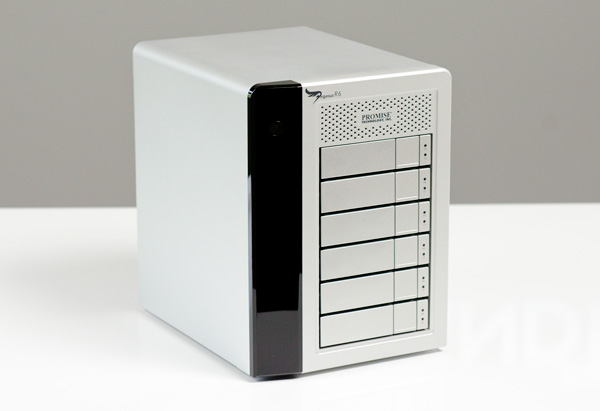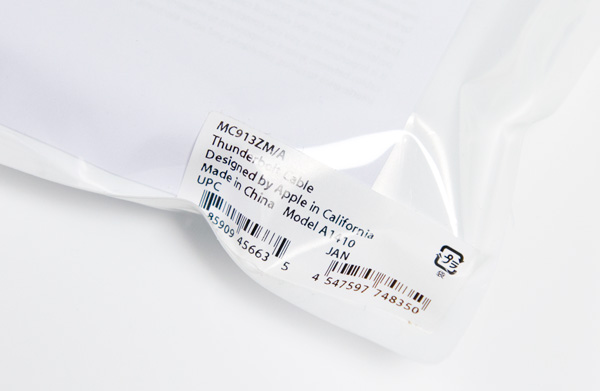Promise Pegasus R6 & Mac Thunderbolt Review
by Anand Lal Shimpi on July 8, 2011 2:01 AM ESTFinal Words
There are really two things that need concluding in this article. We'll start with the Promise Pegasus R6. Without a doubt this is the highest performing external enclosure you can get for your 2011 MacBook Pro or iMac. Even using lowly mechanical hard drives you can get absolutely amazing sequential performance out of the R6. In its beefiest configuration you get 10TB of storage that you can readily access at over 600MB/s. For a MacBook Pro or iMac user that does a lot of HD video work, this amount of high speed storage is just unheard of. The big tower guys have always been able to piece together beefy RAID arrays, but now you're able to get that sort of an experience in a more compact computing device.
I'd love to see Promise offer a version of the Pegasus with SSDs instead of mechanical drives. If Promise didn't want to retool the Pegasus' design it could come in the same chassis, but it'd be really nice to see an even smaller form factor chassis designed exclusively around the 2.5" form factor. I've already shown what four high speed SSDs can do in the R6's chassis. You obviously don't get the capacity but I suspect there's a class of users out there that needs more than what a MacBook Pro can offer with its internal drive bays, but doesn't quite need 10TB of storage.
The Promise Utility that comes with the Pegasus is nice but I found it slightly temperamental at times. I almost feel like we're another couple of software/firmware revisions away from a more polished solution, although admittedly I didn't encounter any issues when I was just using the device as configured.
The biggest drawback to the Pegasus is its price. At $1999 fully loaded, or $999 for an entry level 4TB R4 it's just a very difficult device to justify. I suspect if your work depends on it then you'll have no problems spending the money, but it is a very niche product as a result. I would like to see Promise or someone else offer a barebones Thunderbolt chassis for those users who need this sort of performance but at a better price point. I can understand the price premium for Thunderbolt, but at these prices the technology is simply out of the reach of too many who could honestly use it.
Which brings me to the next topic of discussion: Thunderbolt. The interface is fast, there's no doubt about that. With the right drive configuration I had no problems pushing 8Gbps over the PCIe channel while sending another ~7Gbps over the DisplayPort channel to a 27-inch monitor. It's clear that Thunderbolt has what it takes to really enable more users to migrate from big desktops to high powered quad-core notebooks. The interface effectively solves the high speed local storage issue.
I'd love to see Apple get really aggressive here and offer a Cinema Display with two Thunderbolt ports, more USB ports, Ethernet and audio out. Then MacBook Pro users would only have to run a single Thunderbolt cable + power to their notebooks when they're docked at a desk. I'd also like to see full-speed performance when used in Target Disk Mode. Thunderbolt could become the new defacto way to quickly migrate data between Macs.
I am concerned that we may run into bandwidth limitations in the not too distant future. If we can already push 5 - 8Gbps of data on a single channel, what happens when you run Gigabit Ethernet and USB over Thunderbolt as well. For high end users, I see a definite need for faster signaling or multiple Thunderbolt ports.
I also have concerns about cable costs and widespread adoption. For Thunderbolt to really take off we need to see tons of products that support it. Intel's Thunderbolt controller IC can't be cheap, so I am curious to find out if more companies will give Thunderbolt a try. I believe cable costs can be prohibitive, but today device costs are the bigger concern.
Intel already announced that we'd see Thunderbolt support in Ivy Bridge designs next year so it may be at least one more year before we see just how much market potential Thunderbolt has. While I'm happy that Apple is championing the standard, Thunderbolt really needs widespread industry support to make an impact.












88 Comments
View All Comments
darwinosx - Friday, July 8, 2011 - link
Hardly anyone uses projectors so VGA ports should only be on business class laptops.Zok - Friday, July 8, 2011 - link
Can't say I agree with you there. Despite being issued a corporate laptop, I use my personal one for most of my work, including (VGA-requisite) projector presenting.cacca - Friday, July 8, 2011 - link
some questions:Does USB 3 port do the same?
Does the PCI-E external do the same?
Does External SATA do the same?
Thunderbolt is just another PROPRIETARY standard that competes with others.
It reminds me RAMBUS.
were cost and compatibility matters. Is faster but....
We will ever seen a review of something from Intel that points out the shortcomings?
or this place is ADDtech instead of anandtech?
André - Friday, July 8, 2011 - link
Rest assured that USB 3.0 does NOT in any way or form do the same as Thunderbolt.The protocols are very different, as in, USB 3.0 nearly doesn't support any and Thunderbolt being an extension of a 4 x PCI-Express slot does support heaps of features, like Target Disk Mode, S.M.A.R.T.-status, Native Command Queuing, daisy-chaining (with very low latency) making it ideal for many professional applications (Audio/Visual devices), bi-directional bandwidth, DisplayPort, 10 Watt of power and native software driver support.
Just to name a few.
External SATA doesn't do the same either.
Thunderbolt is a multi-purpose connector, not limited to only storage or transfer of files.
If you for a minute think that USB or E-SATA does the same as Thunderbolt, then you need to educate yourself.
It has the potential to replace all other external connectors. One cable to rule them all, instead of legacy cables that clutter up the backside of your computer and collect dust.
Anato - Friday, July 8, 2011 - link
And one controller (maker) to rule us all. Thats a big problem in PC, but not necessarily in Mac.Jaybus - Sunday, July 10, 2011 - link
Not really. Light Peak is essentially protocol agnostic. It tunnels PCI-E. The PCI-E-to-whatever bridge is built into the cable and/or dongle. In other words, a USB 3.0 adapter/hub that plugs into a Light Peak port is possible and even likely.While Intel may control the Light Peak controller, which will no doubt be integrated into motherboard chipsets, I don't think that will give them a monopoly on the bridge chips that make LP actually useful.Exodite - Friday, July 8, 2011 - link
Cue 'potential'.It's not hard to foresee another Firewire or mini-DP in the making, or a Beta if you prefer going old-school.
Coupling Light Peak technology with mini-DP was a mistake. The technology is new, unproven and offers precious few usage scenarios with non-existent device support. Piggy-backing it on mini-DP, which suffer from pretty much exactly the same issues, won't help adoption rates.
Choosing USB over mini-DP as the 'legacy' interface would have been a much better choice.
André - Friday, July 8, 2011 - link
Except that the USB connector is only allowed to be used as an USB connector.DisplayPort is also vastly superior to any other display cable standard, so I cannot see the problem in that regard. Mini-Display is already shipping in millions and millions of computers, as well as Mini-DisplayPort. The same can be said by Thunderbolt, even though it is only Apple who have fully embraced the technology.
As a professional in the audio/visual segment I can hardly see the problem with it being a repeat of FireWire, because my market usually adopts the better technology despite of a small price increase. Of course, it helps that we only use Apple computers to begin with and have already ditched all the back-alley, legacy connectors.
Uritziel - Friday, July 8, 2011 - link
Heh, yet another continuation of the myth that media professionals only use macs...André - Friday, July 8, 2011 - link
Kindly don't put words in my mouth ;)I didn't say media professionals only use Apple computers, I said my company only use them.
As for now it only makes sense to discuss Thunderbolt and Apple computers as Apple are the only ones who has it currently.
But you just have to look at the companies that are releasing Thunderbolt enabled devices to understand that this connector is really something professionals are going to use. Next year the market will open up when PC vendors finally, if they so choose, to embrace the technology.